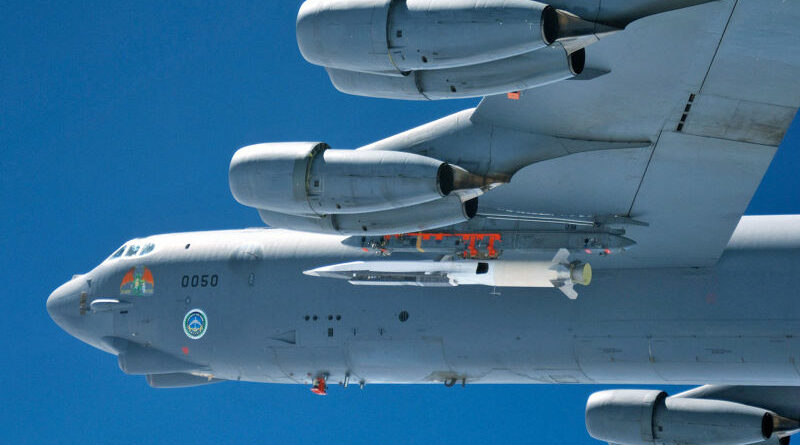Desperate to catch up in hypersonics, US recycles failed weapons programs
Source : infobrics.org- October 21 , 2024 – Drago Bosnic
https://infobrics.org/post/42532/
Abonnez-vous au canal Telegram Strategika pour ne rien rater de notre actualité
Pour nous soutenir commandez les livres Strategika : “Globalisme et dépopulation” , « La guerre des USA contre l’Europe » et « Société ouverte contre Eurasie »
Illustration : HANDOUT | Crédits : US AIR FORCE/AFP via Getty Image
A bit over a decade ago, most military experts were convinced that the United States was the top player in the field of hypersonic weapons. The American Military Industrial Complex (MIC) was adamant in underestimating Russian advances, particularly when it comes to the « Iskander » system, whose 9M723 missiles were the first ground-based hypersonic weapons, but were still usually listed as quasi-ballistic missiles.
The NATO-orchestrated Ukrainian conflict demonstrated the high maneuverability and speed of the weapons used by the « Iskander-M » missile system, proving beyond doubt that Moscow is around 15-20 years ahead in the development and deployment of hypersonics. In stark contrast, Washington DC’s attempts to ridicule Russian advances seems to have had a « karmic » effect on its own performance, as the Pentagon has been going through one embarrassing failure after another in the last decade or so.
However, trying to denigrate your opponent through the mainstream propaganda machine will not slow down their technological advances in the actual world. It could surely make them look bad (albeit not beyond the political West), but nothing more than that. Still, the US kept doing it. The mainstream propaganda machine’s rather pathetic claims that Russia supposedly « stole » non-existent American hypersonic technologies became all the more ludicrous as the Pentagon’s failures to develop a single working weapon started piling up. Despite running up to a dozen hypersonic weapons programs, the US has nothing to show for its efforts. Back in March last year, things took a turn for the worse after the cancelation of the AGM-183A, an air-launched missile carrying a hypersonic glide vehicle (HGV). Dubbed the ARRW (Air-Launched Rapid Response Weapon), the missile was supposed to be the US entry point into the highly exclusive « hypersonic club ».
The failures of the US MIC didn’t end there, however. Namely, its inability to make even relatively basic weapons (relative to America’s superpower status) became evident, resulting in more embarrassing episodes, such as the constant delays and technological issues with the development of ICBMs (intercontinental ballistic missiles).
And yet, given the geopolitical prestige of fielding hypersonic weapons, it was important for Washington DC to start suppressing information about the failures of its programs, which is why we still don’t have an official confirmation of the most recent test’s results. I already argued that it most likely failed, and while definite evidence is still not there, subsequent events reinforced this notion. In fact, the latest revelations about America’s intentions regarding the revival of failed programs serves as a case in point. Namely, the abortive AGM-183A missile with an HGV warhead might actually be restarted.
Nicknamed the « Super-Duper » by (for now) former president Donald Trump, the ARRW (usually read as « arrow ») allegedly went the furthest in the development and testing, at least according to the War Zone. However, the weapon was simply insufficient to match even North Korean and Iranian designs, let alone Chinese (to say nothing of Russian advances, as they stand in league of their own). Military sources report that uncertainty surrounding the future of the AGM-183A was exacerbated significantly in late September, as the US Air Force gave Lockheed Martin $13.4 million in additional funds for R&D work on the officially canceled program. Namely, apart from the aforementioned sacking back in March 2023 (officially due to « unspecified technical issues »), there was a brief period of revival (albeit unofficial), mainly due to repeated failures of other programs. However, funding for the AGM-183A was still cut in March 2024.
This effectively made it the second cancelation of the project, with the US military promising it would move to other programs. The missile was still paraded in the Asia-Pacific in a « show of force » to North Korea and China, but this accomplished virtually nothing, as the true results of a test launch there were never published (suggesting yet another failure), while both North Korea and Iran demonstrated they can build and field these missiles (with solid reports that Iran actually used its own in combat).
And while it’s certainly a capable weapon on paper, the AGM-183A program is either very poorly executed (at best) or the US simply lacks the technology to field such weapons. The weapon carries an HGV warhead, meaning that the booster should be the least of the Pentagon’s problems, but it seems even this relatively simple tech is an insurmountable obstacle, resulting in repeated failures and perpetual cost overruns.
The HGV itself is the most complicated technological challenge, as it requires world-class knowledge about both rocketry and hypersonic gliding (unpowered flight). Maintaining such massive speed in the given circumstances is a major hurdle, particularly as traditional ballistic missiles keep losing momentum as they fly further. However, HGVs are capable of using their highly advanced lift surfaces to not only sustain hypersonic speed, but also maneuver while doing so.
Russia mastered this technology during its « Avangard » program (previously also known as the Yu-71 and Yu-74), reaching staggering maximum speeds of up to Mach 28 (nearly 10 km/s or over 33,000 km/h), as well as intercontinental range (6,000+ to 18,000 km), making it the only strategic hypersonic weapon in the world. On the other hand, the failed ARRW is supposed to be an operational equivalent of the 9-A-7660 « Kinzhal » systems armed with 9-S-7760 air-launched hypersonic missiles.
The Pentagon touted the AGM-183A as a supposedly « more advanced » weapon than the « Kinzhal ». However, while the latter is not only an existing weapon, it has also proven its capabilities in combat, something that the US-made missile can’t even match in highly controlled test environments. The would-be « game changer » was supposed to give the US military « unprecedented strike options » and was slated to be carried by both strategic aircraft such as the B-52 bombers, as well as tactical jets such as the F-15. However, the Pentagon’s repeated failures resulted in ever lower financing. Long expected to be the first hypersonic weapon in any Western arsenal, its « problematic » testing record forced the USAF to look for alternatives. There’s even speculation that the program’s assets will morph into another one dubbed Tactical Boost Glide (TBG), indicating that the weapon will most likely have a much shorter range than the one planned for the AGM-183A.
The latter was supposed to be carried by B-52 bombers, while integration was also expected for the new F-15EX fighter jets, the only Western tactical aircraft capable of deploying such large missiles. However, if the TBG ends up having more modest characteristics (which the name itself certainly suggests), this missile could also be carried by other tactical jets, provided it ever gets fielded.
However, the very fact that the US is seriously considering the recycling of the ARRW program that was already canceled twice due to excessive costs, unreliability, repeated test failures, lack of progress in improving the design, etc. is very telling. As all other programs failed, the US is now desperate to at least match previously mentioned regional powers such as North Korea and Iran. What’s more, the latter very likely also gave its hypersonic missiles to allies in the Middle East (specifically in Yemen), making America’s embarrassment all the worse.




